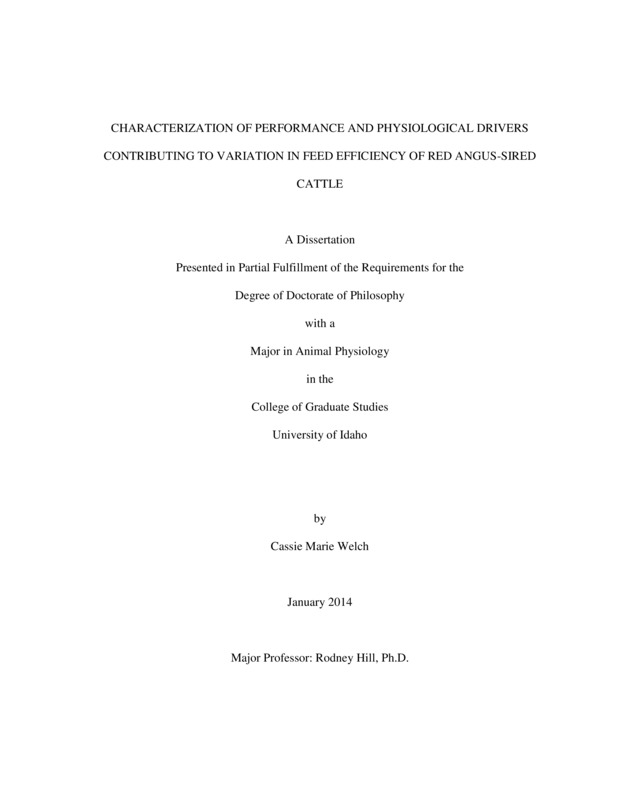CHARACTERIZATION OF PERFORMANCE AND PHYSIOLOGICAL DRIVERS CONTRIBUTING TO VARIATION IN FEED EFFICIENCY OF RED ANGUS-SIRED CATTLE
Welch, Cassie Marie. (2014). CHARACTERIZATION OF PERFORMANCE AND PHYSIOLOGICAL DRIVERS CONTRIBUTING TO VARIATION IN FEED EFFICIENCY OF RED ANGUS-SIRED CATTLE. Theses and Dissertations Collection, University of Idaho Library Digital Collections. https://www.lib.uidaho.edu/digital/etd/items/welch_idaho_0089d_10069.html
- Title:
- CHARACTERIZATION OF PERFORMANCE AND PHYSIOLOGICAL DRIVERS CONTRIBUTING TO VARIATION IN FEED EFFICIENCY OF RED ANGUS-SIRED CATTLE
- Author:
- Welch, Cassie Marie
- Date:
- 2014
- Keywords:
- EPD IGF-I Maintenance energy Physiological mechanisms Red Angus Residual feed intake
- Program:
- Animal and Veterinary Science
- Subject Category:
- Agriculture; Animal sciences; Physiology
- Abstract:
-
There is considerable individual animal variation in feed intake, growth rates and maintenance requirements of beef cattle, but there is a lack of understanding regarding the impact of selection for feed efficiency (FE) and the physiological mechanisms that regulate this production efficiency trait. Therefore, the objectives of this study were to evaluate associations between residual feed intake (RFI; a measure of FE) and economically relevant traits of beef production and to identify physiological mechanisms driving variation in RFI.
Three cohorts of progeny (n = 222) from Red Angus (RA) sires divergent for maintenance energy (MEM) EPD were evaluated for postweaning RFI and finishing phase FE. Progeny performance along with putative mechanistic indicators of FE were analyzed and reported across three categories: 1) relationships among performance traits, RFI, and product quality, 2) associations of serum IGF-I concentration, candidate genes, and fiber type composition with variation in RFI, and 3) relationships between progeny performance traits and sire MEM and RFI EPD.
Results indicated that RFI measured during the postweaning growth phase is indicative of FE status in the finishing phase of beef production. In addition, neither postweaning RFI nor sire MEM EPD negatively affected carcass or end-product quality, and no phenotypic association between postweaning RFI and sire MEM EPD was observed.
Serum IGF-I concentration at weaning was not an indicator of the postweaning RFI phenotype in this study, although IGF-I was strongly and positively correlated with RFI EPD and strongly and negatively correlated with MEM EPD. The identification of potential candidate genes that may be contributing to variation in RFI was inconclusive. The GH-IGF-I axis appeared to have some involvement with RFI at the molecular level; however, gene expression results were not consistent across cohorts. Additionally, results indicated that low RFI animals may have the ability to more efficiently maintain and accrete muscle mass due to their fiber type composition, specifically a greater proportion of type I fibers.
The heritability of RFI in this population of RA cattle is similar to that of other breeds evaluated for postweaning RFI. Sire MEM EPD was found to be associated with measurements of growth and body size, while sire RFI EPD was more closely associated with DMI. Also, sire MEM EPD and sire RFI EPD were not associated, indicating that selection for reduced MEM does not inadvertently select for improved RFI.
In conclusion, this scientific study has identified performance and mechanistic variables that may be contributing to the variation in RFI. Additionally, it has characterized MEM EPD in the context of RFI. These findings will contribute to the growing body of knowledge regarding RFI as a measurement of FE and have potential to impact the use of MEM EPD as an indicator of energy expenditure by the RA breed association and the beef industry.
- Description:
- doctoral, Ph.D., Animal and Veterinary Science -- University of Idaho - College of Graduate Studies, 2014
- Major Professor:
- Hill, Rodney
- Committee:
- Murdoch, Gordon; Hall, John; Ahola, Jason
- Defense Date:
- 2014
- Identifier:
- Welch_idaho_0089D_10069
- Type:
- Text
- Format Original:
- Format:
- application/pdf
- Rights:
- In Copyright - Educational Use Permitted. For more information, please contact University of Idaho Library Special Collections and Archives Department at libspec@uidaho.edu.
- Standardized Rights:
- http://rightsstatements.org/vocab/InC-EDU/1.0/

